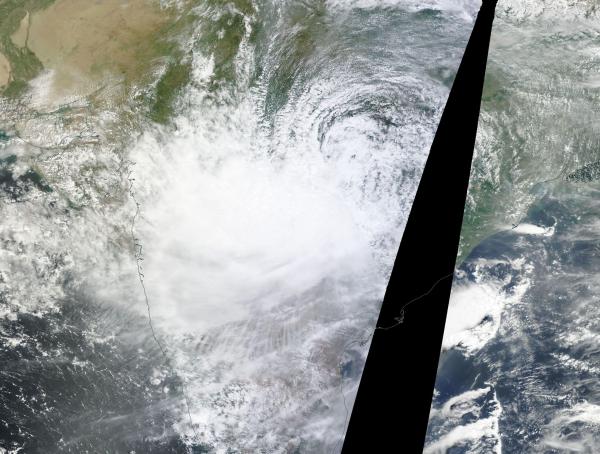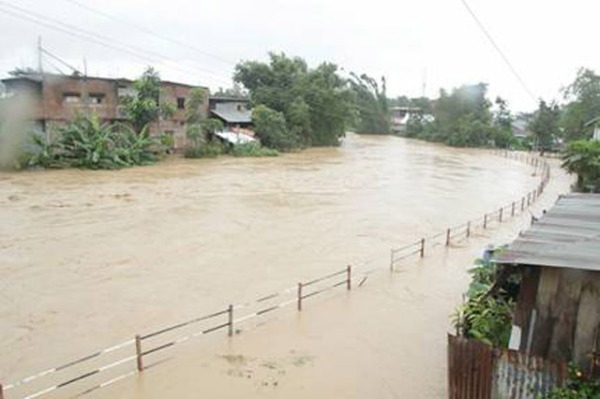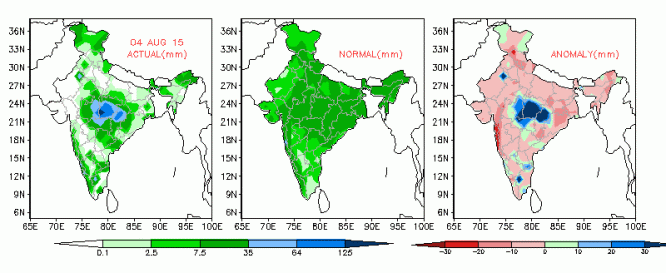Worst Flood in 200 Years — 1.2 Million People Displaced by Rising Waters in India
4
August, 2015
When
you’re rolling with loaded climate dice the situation, as
Indian disaster relief officials stated earlier today,
is indeed grim.
*
* * * *
The
Earth has been warmed by 1 degree Celsius over the past 135 years due
to hundreds of billions of tons of fossil fuels burned. That’s a
pace of warming more than 10 times faster than at the end of the last
ice age. And with that one degree Celsius of global temperature
increase, we
get a 7 percent increase in the rate of evaporation and
precipitation.
Unfortunately, that heat-driven alteration in the hydrological cycle
is not even. In some places, where the heat piles high into great
atmospheric domes and ridges, we see excessive drought. In other
places, the moisture finds a weak spot in the heat and then we see
inundation. The ridiculous country-spanning floods that have now
become all-too-common.
(The
remnants of tropical cylcone Komen combine with a monsoonal flow over
India to produce severe storms over Central and Western India on
August 4, 2015. Image source:LANCE-MODIS.)
Droughts
and floods of a severity that we are not at all used to and that have
greatly contributed to increasing extreme weather events
worldwide. Events
that over the past seven years displaced nearly 158 million souls.
Sadly, that
dread toll of displacement, loss of homes, and loss of lives
continued this week in South Asia as a flood of Biblical scale
devoured an enormous swath of and.
Drought,
Heat Mass Casualties, then Food
For
this summer, the situation in India, Bangladesh and Myanmar has been
one of drought and flood combined. Earlier this year, the arrival of
monsoonal moisture was delayed by the influence of a powerful heat
dome crouched over the region. In India, the high temperatures and
humidity were so intense that tens of thousands were hospitalized
and thousands
lost their lives due to heat stroke.
Official reports from the region indicated that a precipitation
deficit of 10 to 30 percent or more was in the offing. But that was
before the skies, super-charged with moisture through an
unprecedented rate of evaporation, opened up.
Last
week, a
frail but rainfall dense tropical cyclone Komen slammed into the
coast of Bangladesh.
This storm combined with the heavy load of monsoonal moisture
building over the region. These conjoined systems have since dumped
from 300 to 1300 millimeters of rainfall (more than four feet of rain
for some locations) over a broad region including Bangladesh,
Myanmar, and the Bengali state of India. It’s a rainfall amount
that measures not in inches and millimeters, but in feet and meters.
And when you get that much rain there’s going to be some severe
hell to pay.
Worst
Flood in 200 Years, 13,000 Villages Under Water, 1.2 Million People
Displaced
Heavy
monsoonal rains are ‘normal’ for India during this time of year.
And, as is typical with media outlets who seem mentally incapable of
reporting on the impacts of human-caused climate change and related
extreme weather these days, many are attempting to claim that the
current epic rainfall in India is somehow part of a typical pattern.
Nothing could be further from the truth. For by August 1 (two days
before the Bengal rains began to shift westward) the day-on-day
piling up of water had amounted
to the worst flood experienced in all of 200 years of record keeping
for the hardest hit regions.
It’s
a media silence that pervaded in the earlier stages of this unfolding
disaster. One in which only a trickle of reports hit the net or
presses. A silence that led one
minor local media outlet to issue this irate statement:
Chandra says media has completely ignored this flooding, including the state’s print media and television news channels. The media are mainly based in the state capital, Imphal. The state government is in total chaos and is completely unprepared to tackle the situation. No higher zone is left within the districts, and people are taking shelter in nearby hill stations.
In
other words, the only solution for Bengalis during the first few days
of this 200 year or worse flood event was to run to the hills.
(By
Saturday, August 1, flood waters had already surged over river banks
and inundated communities like Manipur. Now, more than 13,000
villages and in excess of 10 million people have been impacted. Image
source: Blaze.)
Since
that time, government and mainstream media response has been more
widespread, even if most reports have not set the current extreme
event in its proper climate change related extreme event context.
Irregardless of this widespread failure, yesterday, as reports rolled
in that more than 11,000 villages had been buried by water in Bengal,
the extreme nature of the situation began to settle in. Sparse
news coverage indicated that at least a million people had been
impacted and that flood refugees were beginning to pour into disaster
shelters.
By this morning, a more accurate assessment of the full scope of this
disaster had been taken. Over
13,000 villages had been flooded out, more than 10 million persons
had been impacted, and the official government count for persons
huddling in disaster shelters had climbed to 1.2 million souls.
“Rivers
in 13 districts are flowing over their danger marks. The situation is
grim,” noted
disaster management minister Javed Ahmad Khan to AFP.
Lives
lost from the flooding have steadily and ominously increased to over
180. But with so many roads and bridges washed out. With so many
villages still under water, it will takes weeks before a full account
is made of this year’s excessively severe flooding.
(Heavy
rainfall is now focused over Central India with 125 mm [5 inches] or
locally higher amounts centered east of Mumbai and southeast of
Dehli. Image source: Monsoon
of India.)
Severe
rains have since shifted to central portions of India so the hard-hit
Bengal regionshould
be able to start picking up the pieces. Now it’s Central India
that’s falling under the gun as monsoonal moisture is pumped up
into towering thunderstorms by Komen’s circulation and southerly
outflow.
Storm
Heading Toward Mountains
Over
the next few days, the
most intense storms associated with Komen’s monsoonal interaction
are expected to shift north and west, eventually stalling out over
the mountainous regions of Northern India and Pakistan.
Such a storm track risks increased rates of rainfall over high
mountain glaciers. A weather situation that can dramatically
increase glacial ice loss and spike the potential for dangerous
glacier outburst flood events.
Links:
How
Climate Change Wrecks the Jet Stream, Amps up the Hydrological Cycle
to Generate Extreme Weather
Hothouse
Rains Destroy 17,000 Homes in Myanmar
Hat
Tip to Colorado Bob






No comments:
Post a Comment
Note: only a member of this blog may post a comment.